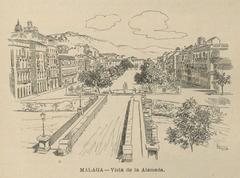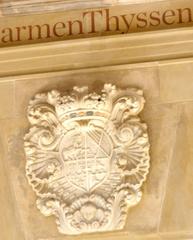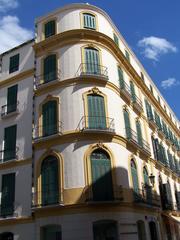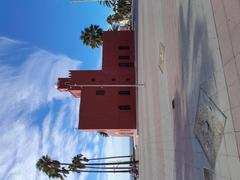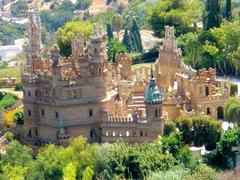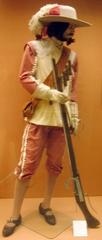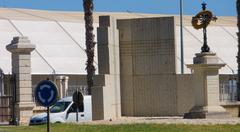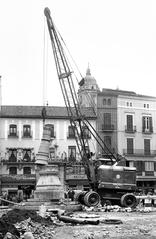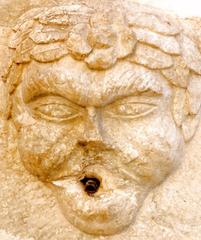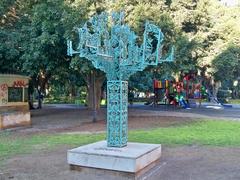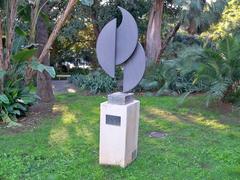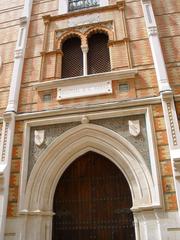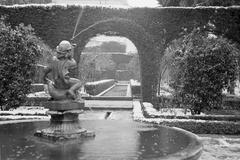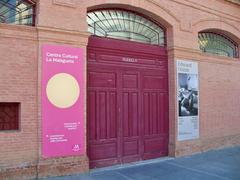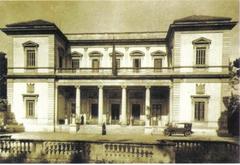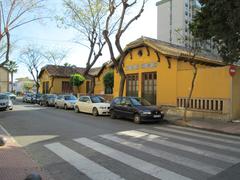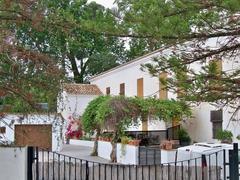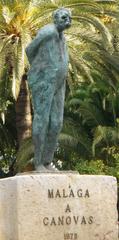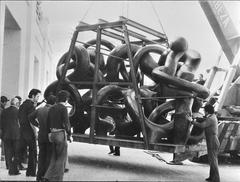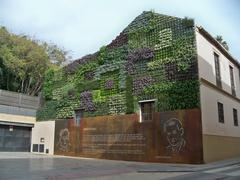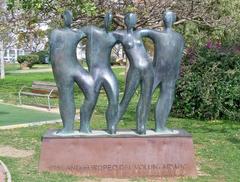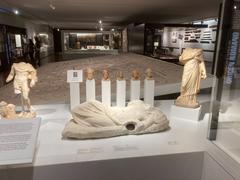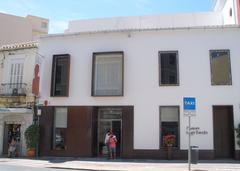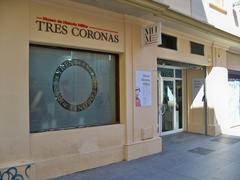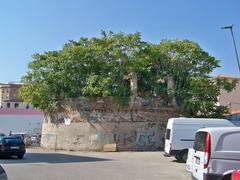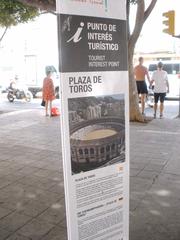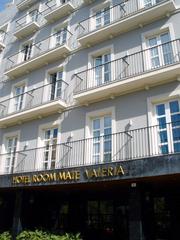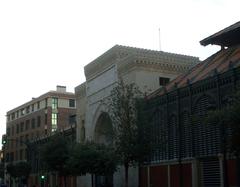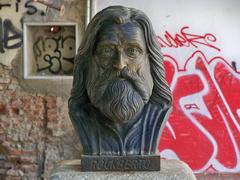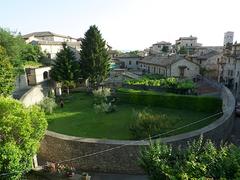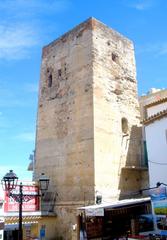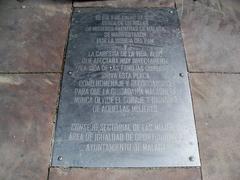Cruz de Humilladero Visiting Hours, Tickets, and Guide to Málaga Historical Sites
Date: 04/07/2025
Introduction to Cruz de Humilladero and Its Significance
Nestled just west of Málaga’s historic city center, Cruz de Humilladero—officially District 6—is a vibrant, historically rich neighborhood offering an authentic Andalusian experience away from the city’s main tourist routes. The district’s name originates from the historic “humilladero” or cross, which once marked the city’s boundary and served as a place of reflection and justice. Today, the cross stands at the intersection of Paseo de los Tilos and Calle del Conde de Guadalhorce, symbolizing centuries of social and cultural transformation (Wikipedia - Cruz de Humilladero).
With origins in the 17th century, Cruz de Humilladero evolved from rural outskirts to a thriving urban area, shaped by industrialization, transportation hubs like the María Zambrano train station, and significant urban developments. The district features a blend of historical landmarks, modern infrastructure such as the Palacio de Ferias y Congresos, and active community spaces that showcase Málaga’s dynamic spirit (Idealista). Its accessibility, with multiple metro stations, bus lines, and proximity to major transport hubs, makes it an ideal base for exploring Málaga’s broader historical and cultural offerings (Ayuntamiento de Málaga).
Whether you are drawn by the area’s historical depth, lively cultural festivals such as Semana Cultural or the Cabalgata de Reyes, or wish to savor authentic Andalusian cuisine along the Ruta de la Tapa, this comprehensive guide will provide essential visiting information, practical tips, and insights into the unique character of Cruz de Humilladero (Malaga.eu - Semana Cultural, El Español - Cabalgata de Reyes).
Table of Contents
- Introduction
- Historical Background and Significance
- Origins and Etymology
- Strategic Location and Early Functions
- Urban Development and Industrialization
- Main Landmarks and Attractions
- Visiting Cruz de Humilladero: Practical Information
- Visiting Hours and Access
- Tickets and Guided Tours
- Accessibility
- Travel Tips and Nearby Attractions
- Social and Demographic Profile
- Cultural Life and Traditions
- Economic and Infrastructural Role
- Frequently Asked Questions (FAQ)
- Conclusion
- References
Historical Background and Significance
Origins and Etymology
“Cruz de Humilladero” translates to “Shrine’s Cross” or “Cross of Humiliation,” referencing a longstanding religious and boundary marker. The earliest documentation of a “humilladero” in Málaga appears in city records from 1600, though the exact reference is debated. It may have denoted a shrine, cross, religious image, or even a site for executions (Wikipedia - Cruz de Humilladero). The prevailing view is that the original cross marked the city’s edge and served as a place of justice.
Strategic Location and Early Functions
Historically, Cruz de Humilladero was a key entry point to Málaga, referenced in the 17th century as the starting location for routes to towns like Cártama and Benalmádena (Wikipedia - Cruz de Humilladero). During times of epidemic, guards at the cross restricted access to prevent the spread of disease. In 1695, it became a site for public executions, underscoring its judicial role.
By the late 19th century, the area was still on the city’s periphery. The construction of Camino de San Rafael in 1867 saw the cross moved to its present location, solidifying its reputation as Málaga’s symbolic threshold (Wikipedia - Cruz de Humilladero).
Urban Development and Industrialization
Cruz de Humilladero began its transformation from rural outpost to urban district in the late 19th century. The opening of the San Rafael Cemetery in 1868 and the building of affluent villas along the Camino de Antequera marked early change. The 20th century brought major civic projects, such as the provincial prison (1931) and municipal slaughterhouse (1940s), reflecting the district’s growing significance (Wikipedia - Cruz de Humilladero).
The 1950s were pivotal, as large-scale social housing projects under Franco’s regime created neighborhoods like Haza Cuevas, Carranque, and Santa Julia. This era’s utilitarian architecture and rapid urbanization set the foundation for Cruz de Humilladero’s modern, diverse identity (Wikipedia - Cruz de Humilladero).
Main Landmarks and Attractions
Architectural and Urban Highlights
- Centro Cívico Huerta Jiménez: Community activities and civic engagement hub.
- Instituto Andaluz del Deporte: Emphasizes sports and youth programs.
- Palacio de Ferias y Congresos: Modern conference and event center, key to the district’s economy (Wikipedia - Cruz de Humilladero).
- Auditorio Municipal: Venue for cultural performances.
- Historic Residential Complexes: Carranque, Santa Julia, and Haza Cuevas illustrate mid-20th-century architecture.
Remnants of the old provincial prison and slaughterhouse, designed by Fernando Guerrero Strachan, highlight the district’s industrial heritage.
Parks and Green Spaces
- Parque de Huelin: Offers walking paths, playgrounds, and a lake; free to enter.
- Parque del Oeste: Located nearby, known for sculptures and fountains.
- Jardines de Picasso: Popular recreational spot.
Markets and Gastronomy
- Mercado de Huelin: Open daily 8:00 AM–3:00 PM, featuring fresh Andalusian produce and delicacies.
- Ruta de la Tapa: Local tapas bars and restaurants serve traditional specialties like espetos (grilled sardines) and gazpacho.
Key Neighborhoods
- La Unión: Busy commercial heart near the train station.
- Haza Cuevas, Santa Cristina, Carranque: Residential areas with shops, parks, and sports facilities.
Visiting Cruz de Humilladero: Practical Information
Visiting Hours and Access
Cruz de Humilladero is an open district, accessible at all hours. Specific sites have individual schedules:
- Palacio de Ferias y Congresos: Mon–Fri, 9:00 AM–8:00 PM; hours vary for events.
- Centro Cívico Huerta Jiménez: Mon–Sat, 8:00 AM–9:00 PM.
Confirm hours directly with venues or on official websites.
Tickets and Guided Tours
Most attractions and streets are freely accessible. Tickets may be required for events at venues like Palacio de Ferias y Congresos or the Auditorio Municipal. Guided tours, often focusing on Málaga’s industrial and urban history, can be arranged through local operators or the tourist office.
Accessibility
The district offers excellent accessibility, with multiple metro stations (Portada Alta, Carranque, Barbarela), train stations (Victoria Kent, Los Prados), and many bus lines. Public spaces and sidewalks are generally suitable for wheelchairs and strollers, though some older neighborhoods may have uneven surfaces.
Travel Tips and Nearby Attractions
- Getting There: Accessible by car, metro, or bus from central Málaga.
- Nearby Sites: University of Málaga campus, Parque de San Rafael, Guadalhorce Industrial Estate.
- Dining & Shopping: Enjoy the Ruta de la Tapa and browse local markets for authentic Andalusian goods.
Social and Demographic Profile
Cruz de Humilladero is Málaga’s second most populous district, with around 88,000 residents (Wikipedia - Cruz de Humilladero). It is home to families, professionals, and students, fostering a lively, diverse community (Idealista). The district is bisected by the Ronda Oeste (MA-20), with residential areas to the east and industrial zones to the west, and is crisscrossed by major thoroughfares like Avenida de Andalucía and Avenida Ortega y Gasset.
Cultural Life and Traditions
Cruz de Humilladero’s calendar is packed with cultural events:
- Semana Cultural: Annual festival featuring sports, storytelling, horticulture, fashion, and concerts (Malaga.eu - Semana Cultural).
- Ruta de la Cruz and Ruta de la Tapa: Culinary and historical walking routes.
- Cabalgata de Reyes: Festive Three Kings Parade with floats and community participation (El Español - Cabalgata de Reyes).
- Neighborhood Fiestas: Each barrio holds annual celebrations featuring live music, food, and family activities.
- Virgen del Carmen Processions: Maritime processions honoring the patron saint of fishermen.
Economic and Infrastructural Role
Cruz de Humilladero plays a crucial role in Málaga’s economy, hosting the Polígono Industrial Guadalhorce, a center for industry and innovation (Idealista). The Palacio de Ferias y Congresos bolsters the local economy as a business and commerce hub. Transportation infrastructure is excellent, with comprehensive metro, train, and bus connections (Wikipedia - Cruz de Humilladero).
Frequently Asked Questions (FAQ)
Q: What are the visiting hours for Cruz de Humilladero?
A: The district is open at all times. Specific venues have their own schedules.
Q: Is there an entrance fee?
A: No, access to the district and most attractions is free. Some events may require tickets.
Q: Are guided tours available?
A: Yes, local operators and the tourism office offer guided tours.
Q: Is the district accessible for people with disabilities?
A: Yes, with accessible public transport and infrastructure.
Q: What are nearby attractions?
A: University of Málaga, Parque de San Rafael, Mercado de Huelin, and the Alcazaba in Málaga’s historic center.
Conclusion
Cruz de Humilladero is an essential destination for those seeking to experience Málaga’s blend of history, culture, and contemporary urban life. From the emblematic cross that gave the district its name to bustling markets, cultural festivals, and diverse neighborhoods, Cruz de Humilladero exemplifies Málaga’s spirit of resilience and growth. Whether attending a festival, sampling local cuisine, or joining a guided tour, visitors will find the district welcoming and full of discovery.
For the latest updates on events, tours, and practical information, download the Audiala app and consult official tourism resources.
References and External Links
- Wikipedia - Cruz de Humilladero
- Idealista - Vivir en Cruz de Humilladero
- Ayuntamiento de Málaga - Junta de Distrito 6
- Malaga.eu - Semana Cultural
- El Español - Cabalgata de Reyes
- Rome2Rio
- Travelling King - Where to Stay in Malaga
- Guide to Malaga - Events in July
- Wanderlust Chloe - Málaga Things to Do
For more detailed travel guides, event updates, and interactive maps, download the Audiala app or visit the District 6 official page.
